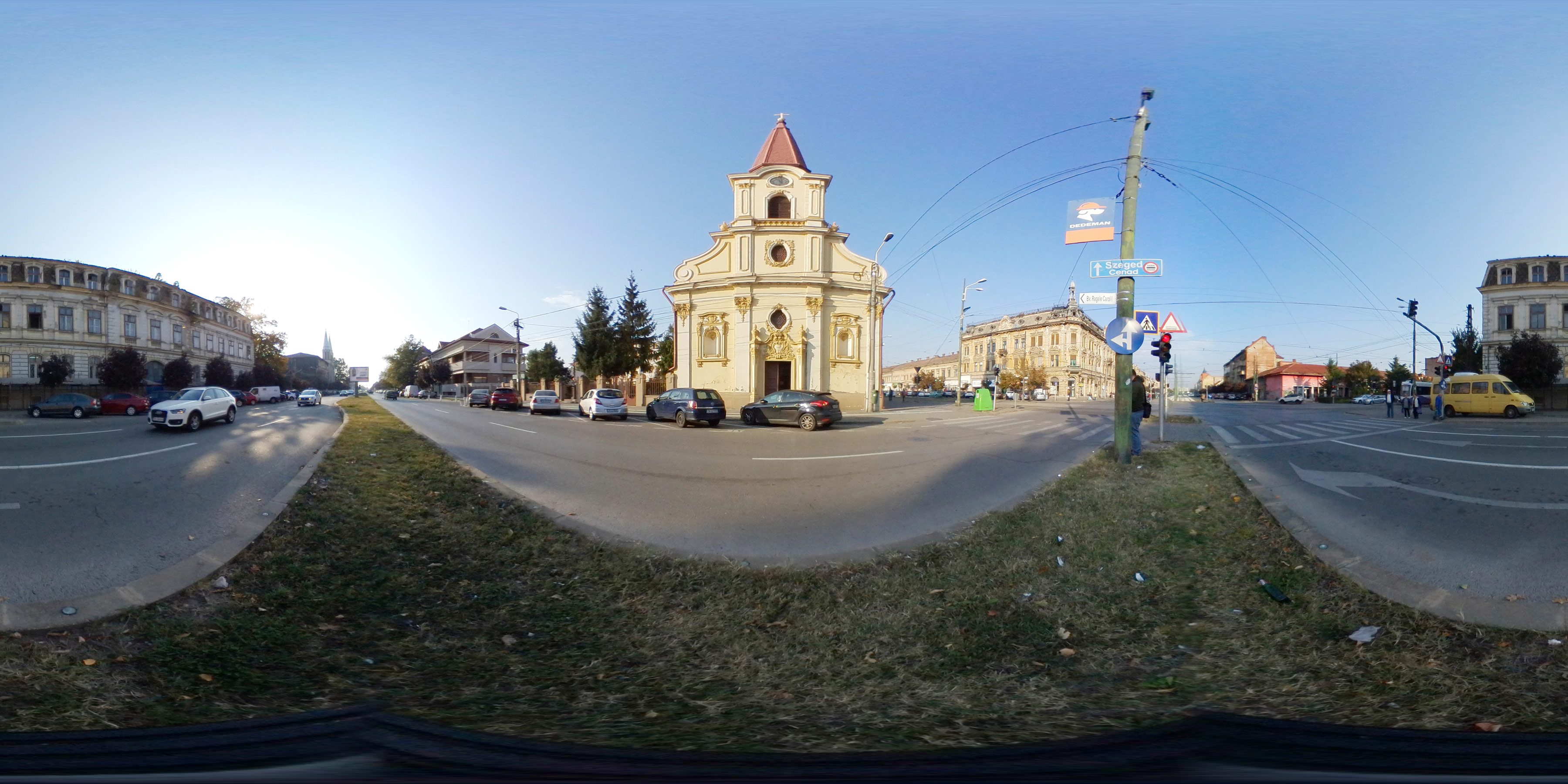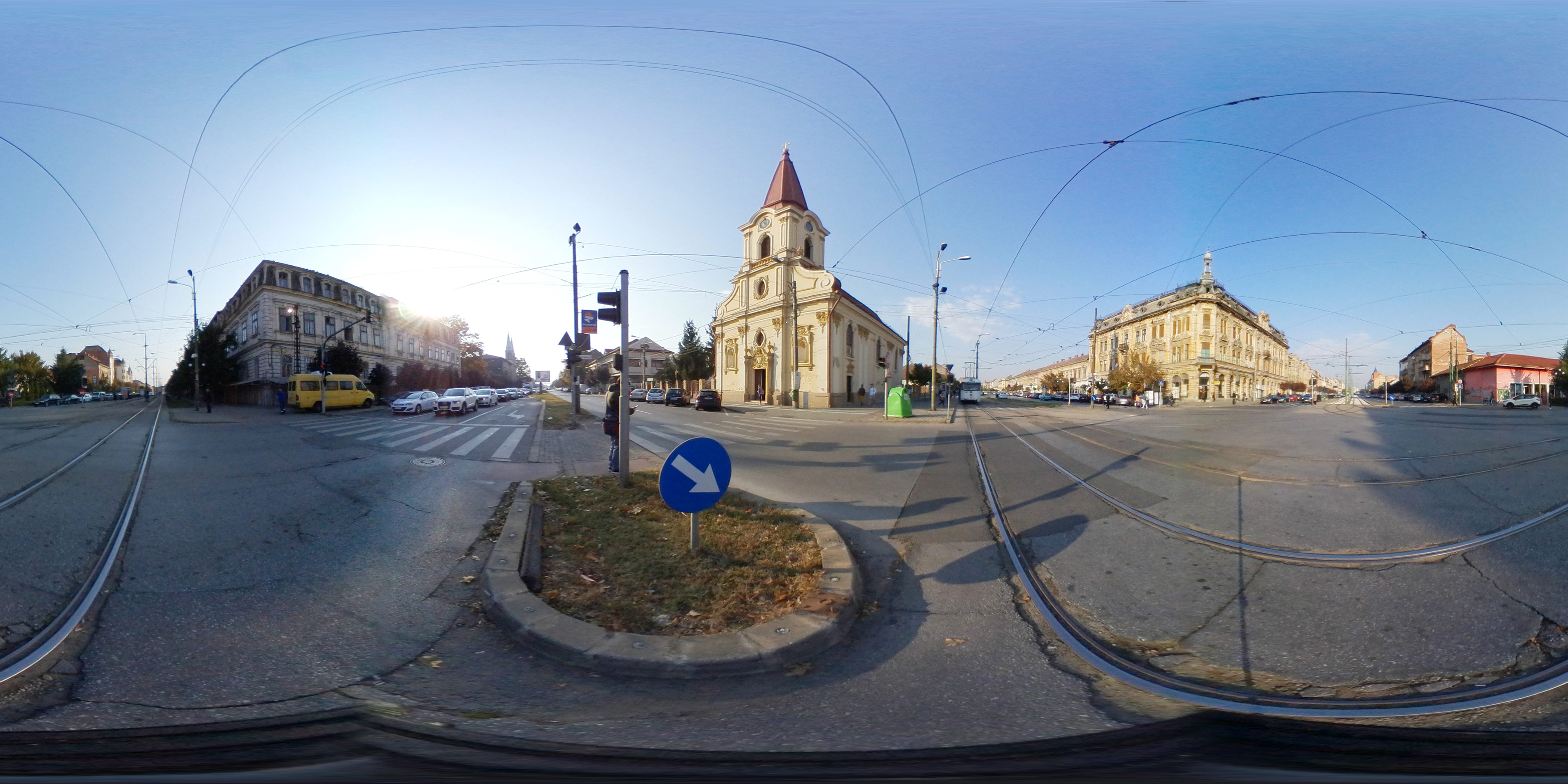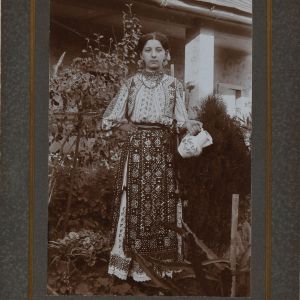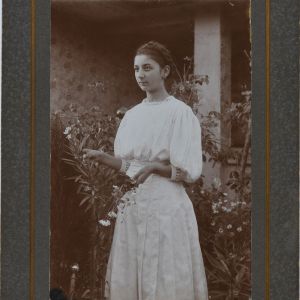Carol I Boulevard no. 13
The Roman-Catholic church, "The Birth of the Virgin Mary", was built between 1774-1775 in the late baroque style. The Nôtre-Dame complex in Iosefin is a building complex built in 1881 with a fund of 100,000 florins donated by Alexandre Bonnaz, the Roman Catholic bishop of Cenad.
Listen to the audio version.
The Roman-Catholic church of “The Birth of the Virgin Mary”, was built during 1774-1775 in the the late baroque style.The original project of the church was signed by provincial engineer Carl Alexander Steinlein, on October the 17th, 1768. During the 1848 revolution the tower of the church was severely damaged by the fortress garrison artillery and was repaired in 1861 by the architect Johann von Schuster while the tower spire was raised in 1889.
The The Nôtre-Dame compound in Iosefin is a building complex built in 1881 with a fund of 100.000 florins donated by Alexandre Bonnaz, the Roman Catholic bishop of Cenad. The ensemble consisted of a garden arranged as a park, the novitiate, the normal school for teachers and a boarding school. By the end of the 19th century, the complex included the elementary school, a day nursery for children, the Superior School for girls, the Superior Pedagogical Schoolthe monastery building, the boarding school including the dormitories for schoolgirls and the building of the communal school. The monastery also managed a kindergarten and a school where handwork and crafts were taught.
The monastery church was built in 1894, in a Neo-Romanic style and consecrated on October 8, 1895, with the dedication of the "Sacred Heart of Jesus". The four bells were executed by the Timisoara foundry workshop of Anton Novotny, and the pipe organ is the work of Leopold Wegenstein of Timisoara. After the 1989 revolution the liturgy is celebrated in German, and every Sunday also in Bulgarian.
The two-storey building next to the church has neo-Gothic and neo-Roman elements. The older building, located behind a court of honor, created in an eclectic historian style, is the headquarters of the Serbian high school Dositej Obradovici.
During 1935 -1937 a new building of the school complex was designed by architect Michael Wolf, in the Bauhaus style, which houses today the Student Culture House..
More details about the building can be found by accessing the dedicated web page within the cultural project Heritage of Timisoara, and for a complete experience, the building can be visited within the Building and restoration - Iosefin and its public squares.
and Notre Dame complex
Listen to the audio version.
Listen to the audio version.
Schoolgirls at Notre Dame, Iosefin
Excerpt from an interview with Luciei Jivan (b.1923), interviewed by Voichița Năchescu in Timișoara in 2001 (Colecţia de istorie orală a Bibliotecii Centrale Universitare “Eugen Todoran” (Oral History Collection of the Central University Library "Eugen Todoran") in Timișoara. Coordinator Smaranda Vultur)
(...) I would say I should start from 1937-1938, when I left Orșova and came to Timișoara. At boarding school, at Notre Dame. This school, Notre Dame, with my present mind I find it really extraordinary and splendid. I must tell you that there were several schools there, in the premises of this building. There was a high school in Romanian, there was a gymnasium in Hungarian, there was a gymnasium in German, and there was a Şcoală normală, which trained teachers in German. I went to the so-called Roman Catholic high school, with the Romanian language of teaching. The teachers I had were all nuns. I didn't have any teacher who was not in this nun's clothing. With my mind now, I say that they were exceptional teachers. Very good. In what sense: they were able to engage the students and make them think about the subject they were teaching, and I can't forget that the most important and most beautiful classes were the French classes. Because that teacher - God rest her soul! - Sister Gerda, taught in such a way that you had the impression that you were at the theater. For example, we did these great authors, Moliėre, Racine, Corneille, especially I don't forget Molière, who sat at the desk, stood up and talked like that, so that you had the impression that you were at the theater and that you could hear the actor who spoke. Very beautiful.
We were very well prepared, that's in terms of high school, in terms of our boarding school life, because I was a boarder, we had like this: one week in German and one week in French, so French and German, so one week and one week. Those were the languages spoken at boarding school. The nuns were extraordinarily nice. In the sense that they created beautiful moments for us. For example, when it was a girl's birthday, there was no such thing as going unnoticed or not being celebrated. We had record players inside, we had a tennis court, we had a skating rink, but on these days when one of the girls was celebrating a birthday, the record player was turned on, there was dancing, of course, girls with girls, but in any case it was a party. And we were all in a very good mood, but we had to be extraordinarily tidy, not to leave any dirt behind us, not to leave things scattered, everyone had their place at the table and in the boarding school.
While we were studying, there was always this Sister Gerda who was the head of the boarding school and who helped us with languages, and we had another nun, Sister Chiara, who helped us with science, mathematics, physics and chemistry. If we didn't know how to do our homework. So we had help. In the boarding school the bedrooms were for five people when we were older, and when we were younger, for ten or so. The beds had to be extraordinarily beautifully made, not like this one (shows the bed she' s sitting on) and the sheet stretched out so that you could write on it, like this, and in the morning at six o'clock it was the time for getting up. We'd get up, say our prayers. We'd wash up and immediately go to the gym in the yard, no matter if it was cold, no matter if it was hot, no matter what the weather was, we would be doing gymnastics at half past six.shows the bed he's sitting on) and spread out the sheet so you could write on it, and at six o'clock in the morning it was time to get up. We'd get up, say our prayers. We'd wash up and immediately go to the gym in the yard, no matter if it was cold, no matter if it was hot, no matter what the weather was, we'd be doing gym at half past six.
Afterwards we would go to have breakfast, and then to school. At one, half past one we would come from school, just cross the yard, and go to the boarding school, we had a fixed lunch hour, then tutoring from two to seven in the afternoon. During these hours nobody was allowed to do anything else. If you finished your lessons, you would get a book and read. At nine o'clock sharp - after dinner, of course - at nine o'clock sharp, bedtime. The ones who were in the higher grades, like now the ninth, tenth, eleventh grade, would stay up until half past nine. That was a big favor to us, an extra half hour. Not more, because in the morning at six o'clock it was time to get up. What else can I tell you? As for the training I told you, it was extraordinary, there I took the entrance exam for higher education and I remained there and I went on to high school there and I also took the baccalaureate there. That would be about Notre Dame School, so if you have any questions...
((Were you going out in the city?)
So we weren't allowed to go out of school in town. We took turns going out every Sunday, taking us to church, so it was each to her respective church. I mean, we took turns with the Orthodox - the Catholics stayed there, because they had their church inside - the Reformed, anyway, and we took turns going to church. If there was a good show, I mean, opera, theater, of course, we took turns. In the evening we would go to the opera, naturally, they would take us regularly to all the performances. So they didn't deprive us of those things. And as many amusements as we wanted, because, as I said skating, tennis were inside the school. So that's what it was. But going out alone, no way. When the parents would come to school, they would take us out and let us out for a day, from morning till ten in the evening we could stay out there.
I had two good friends, best friends, they were all friends there, they didn't make any distinction between nationality, you are this or you are that, nor between religion, even if they were Orthodox or Catholic, everyone was allowed to worship whoever they wanted and to keep their religion. But I had two very good friends, and one was Hungarian and one was German, and the three of us were inseparable. Unfortunately about the Hungarian girl I don't know anything anymore, and the German girl seems to have died, she was taken to the Soviet Union, I don't know exactly, it's not confirmed, but in any case she died. We were very good friends and trusted each other a lot. We used to help each other in lessons, during tutoring we were not allowed to talk, to discuss. The nun who was in charge of the scientific part was there and if we had something to ask, we would go to her and she would show it to us, we weren't left alone so that we wouldn't be able to do our lessons or anything. At the table there was no indulgence, you had to eat everything you were given, and everyone had their own drawer, with cutlery, napkins, everything we needed, sometimes in the morning we hid the buns we didn't like and put them in a drawer and they would get bad.In the end they had no choice but to throw them away or what they did with them, I don't know, but in any case, after we had been given that admonition and guidance (laughs) not to do anything like that again and waste the bread that God had given us. There was a great emphasis on faith, on religion, and it's interesting that even we who were not Catholic went to church there and prayed. For example, to this day I still pray to Saint Anthony, because that's how I got used to it. Since I was a child, I have the little book of St. Anthony, from there, from Notre Dame, which I still use today. (laughs) so that we do not do any more to spoil the bread that God has given us. There was a lot of emphasis on faith, on religion, and it's interesting that we, who were not Catholic, also went to church there and prayed. For example, even today I pray to Saint Anthony, because that's how I got used to it. As a child, I have the little book of St. Anthony, still there, from Notre Dame, which I still use today.
So what should be kept in mind is that there was no distinction of nationality or religion or anything else. We were one and the same, treated absolutely equally and the basis was faith, the emphasis was on faith, on God's help. We were given different lectures about human life, how we should behave and especially when there was a case, which was very rare, of suicide, we were told that God gave us life to live, that we had a duty to live it, whether it was easy or hard. We weren't allowed to complain, that's how we were educated.... and you should know that to this day I keep my religious education. It would be good for children too - I see that the emphasis has begun to be placed on this fact again - it is better when the person who believes in God, is more forgiving, less sinful - I say big words now - but in any case it is not as sinful as someone who doesn't have faith. That's how we were raised.
Excerpt from an interview with Else von Schuster (b. 1925, Anina) conducted by Adrian Onica and Roxana Pătrașcu, Timișoara, 2000 (Oral History Collection of the Central University Library "Eugen Todoran" (Colecţia de istorie orală a Bibliotecii Centrale Universitare “Eugen Todoran”) in Timișoara. Coordinator Smaranda Vultur)
Let's go back to the Notre-Dame period. At school, at Notre-Dame we received a select education, I went to boarding school because I didn't have my parents there and I slowly adjusted (...)
Since we are talking about the nuns now, on Saturdays we would get clean clothes, that means clean underwear and clean socks, because there was a laundry, baskets were available to put clothes and everyone had a number. I had the number 73, I still know it now, and all the laundry, all the clothes had to be marked with that number. And when we would get the clean underwear we had to check to see if anything was ripped.
I want to go back to the sewing of stockings that had to be sewn... A nun would come and she would watch me sewing them. I had learned how to sew stockings from an early age and I was the one who stood out. There was also a desk in the training room, we had a room where we did our lessons and each child had his own fixed place at the table. And we had a drawer with things, there we had to have everything in order, we also had a bigger drawer, in the bigger drawers we kept our books, and before we started the study class, the lesson preparation class, we had to take out the timetable, to see what books, what notebooks we needed to take with us where we were sitting. No walking during lessons, during preparation. We weren't allowed to walk around the classroom. If we forgot something we had to raise our hand and ask permission, and then with a lecture: "you don't have a timetable, you haven't looked before, didn't you know how to prepare?". Therefore, very severe. A nun was at the desk and she was watching us work.
And, because of the sewing of the stocking, I was taken near the desk and my stocking was shown, all around, how beautifully I sewed it. Besides, I was wearing a navy blue uniform and I had black stockings.
...In any case, I received an education, still very good, from the nuns. Whenever we would go to the dining table, we had to walk in a nice line, two by two, and not even talk as we walked to the table, because we were so many, it would have been noisy. Anyway, there' s enough noise at school nowadays. Back then it wasn't allowed. And at lunch too. In the dining room, everyone had their place and everyone had their cutlery and their little napkin and... silence until the food was served. Every week there were two other girls on duty, who brought the soup bowls, the food bowls, who shared the food at the table.
After everything was served and if we were good, there would be a bell and we were allowed to talk while we ate. When the bell rang again (laughs)... silence, we had to stop in the middle of a sentence. (laughs)...quiet, you had to interrupt in the middle of a sentence.
In any case it was discipline... perhaps for these days, it was exaggerated. We were taught discipline and self-control, and that's what we learned. They used to tell us that it's good to restrain yourself when you want to, for example I want now to eat a candy... no, I don't eat it, I restrain myself. That comes in handy if you get sick, you have to diet or... like we suffered during the war.
I was born in '25, I came to Notre Dame in '37 and in '39 the war started, and in '40 other times began...
-How did you spend your free time while you were at Notre Dame?
I stayed at boarding school and we had possibilities there, we had a library, so we could read in our free time, we had a tennis court where we could play tennis or other ball games, and we had a park where we could walk. In winter, on that tennis court, we could skate. They used to take us for walks... but with the nun in the back, two by two we would walk on Doja Street or sometimes up to the Cetate. Sometimes we would meet the group from Banatia - which was a boys' school - they would look at us, we would look at them... Sometimes they would take us to the theater, to shows.
Let me tell you this, with Spatzensingen... Once my mother came to visit. She rarely came because she was so far away. She come to the gate when it was time for a visit and she said in German that she wanted to talk to me. The person at the gate was Hungarian and didn't know German, so she told my mom "Else gegangen zu Spatzensing", meaning that I had gone where the sparrows sing.
There is a famous boys' choir "Wiener Sängerknaben" and so is the choir "Regensburger Domspatzen", i.e. "Regensburg Dome Sparrows". They had their 500th anniversary last year since this boys choir exists. They used to take us to performances, to the Regensburger Domspatzen, and that's why she told my mother that I went there where the sparrows sing (laughs)...
The Roman-Catholic Church in Iosefin neighborhood and the complex of the Notre-Dame nuns
Liana Maria Gomboşiu, Valeria Dr. Pintea. A family novel. Marineasa Publishing House, Timişoara, 2013, p. 189 -190
In 1981, my mother celebrated in Timişoara 50 years since she graduated from the Notre Dame highschool. Joli Schemmel, a former colleague, very hearty, established in Oradea, was in charge of mobilizing “the girls”, who, with few exceptions, have not kept in touch one with the other. My grandmother who enjoyed this kind of meetings and who kept contact with the outliving sisters, provided addresses and probably was much more rejoiced than Valentina for the encounter, 50 years after, of the colleagues. My mother was received as the former number one of the class, and sat next to Schwester Gerda and Schwester Leonilla, the only teachers that were still alive. She was asked to have the official speech. For Mama Mi these things were important and brought her happiness.
Gradually, people in my grandmother’s generation started to die, most of them very old and she searched, instinctively, the company of younger persons. Old age started to seem a burden, though she spoke with a certain humor about this topic. For Hilda Drăgan’s 89th anniversary (“Hilda is in her full capacity, wrote grandmother, she cooks and cans for her two great-nephews, she is happy and takes daily walks close to her house. She has got a lot of courage”), the six friends reunited for coffee and cake, summed their ages and noticed the sum was more than half millennium!
After these small pleasant meetings, Mama Mi wrote “it is nice to rejoice that you live on this earth, sinful as it is; let’s try to find joy by ourselves!”
and Notre Dame complex











































